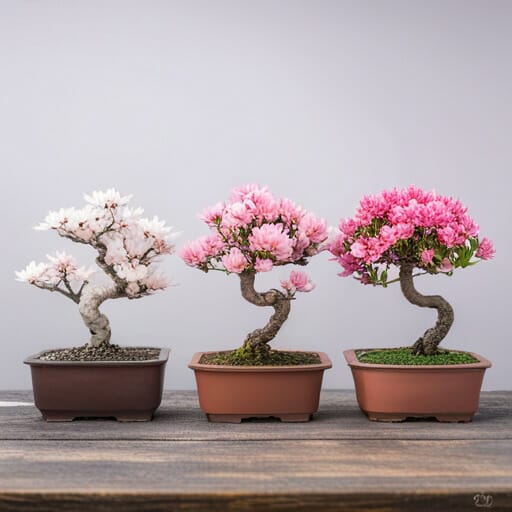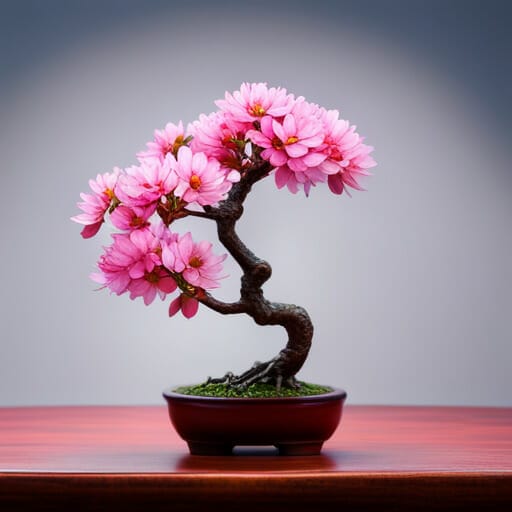Cherry blossom bonsai, with their mesmerizing flowers and captivating foliage, have long been cherished by bonsai enthusiasts for their beauty and versatility. These miniature trees, created from carefully selected cherry tree cultivars, offer a delightful glimpse into the enchanting world of bonsai.
Did you know that there are approximately 200 cultivars of cherry blossom trees, with 10 wild cherry blossom tree species found in Japan? Among these, the Fuji Cherry and the Prunus serrulata cultivar are particularly favored for bonsai due to their small branches, trunks, leaves, flowers, and fruits. With their pale pink and double flowers, these cherry blossom bonsai never fail to impress.
Additionally, weeping cherry trees, with their horizontally spreading branches and delicate white to pale pink flowers, add a touch of elegance to any bonsai collection.
In this article, we will explore the different cherry varieties suitable for bonsai, provide growth and care tips, and delve into the aesthetics and styles that make cherry blossom bonsai truly captivating.
Whether you are a seasoned bonsai enthusiast or a beginner, cherry blossom bonsai are sure to bring joy and fulfillment to your gardening endeavors.
Contents
- 1 Quick Points
- 2 Different Cherry Varieties
- 3 Growth and Care Tips
- 4 Aesthetics and Styles
- 5 Frequently Asked Questions
- 5.1 Are cherry blossom bonsai trees suitable for indoor or outdoor cultivation?
- 5.2 Can cherry blossom bonsai trees be grown from seeds, or is it necessary to purchase a pre-bonsai tree?
- 5.3 How long does it typically take for a cherry blossom bonsai tree to bloom?
- 5.4 Can cherry blossom bonsai trees be trained to have a specific shape or style?
- 5.5 Are there any specific pests or diseases that cherry blossom bonsai trees are prone to?
Quick Points
- Cherry blossom bonsai are cherished by bonsai enthusiasts for their beauty and versatility.
- Proper pruning and regular fertilization are necessary for the health and maintenance of cherry blossom bonsai.
- Cherry blossom bonsai should be placed in a location with ample sunlight and protected from extreme temperatures and strong winds.
– Regular watering is crucial to maintain the proper moisture level in the soil of cherry blossom bonsai.
Different Cherry Varieties

There are various cherry tree cultivars, including Fuji Cherry, Prunus serrulata, Asahiyama cherry, and Weeping cherry, which offer a range of characteristics suitable for bonsai cultivation.
Fuji Cherry is a wild cherry species known for its small branches, trunks, leaves, flowers, and fruits. It is particularly admired for its pale pink flowers that easily bloom even in young trees.
Prunus serrulata, a cultivar derived from Prunus speciosa, is another popular choice.
Asahiyama cherry is a compact cultivar of Prunus serrulata, featuring pink, double flowers.
Weeping cherry, on the other hand, has horizontally spreading branches that fall downward, and its flowers can range from white to pale pink.
These different cherry varieties provide a diverse selection for enthusiasts to create beautiful cherry blossom bonsai.
Growth and Care Tips

To ensure optimal growth and care, it is essential to provide proper pruning and regular fertilization, similar to tending to a delicate garden. Cherry blossom bonsai require careful attention to their growth patterns and specific needs.
Pruning should be done during the dormant season to shape the tree and maintain its desired form. This helps to create a balanced structure and promote the growth of new branches.
Fertilization should be carried out regularly, providing essential nutrients to support healthy growth and vibrant flowers. It is important to use a balanced fertilizer that is specifically formulated for bonsai trees.
Additionally, cherry blossom bonsai should be placed in a location that receives ample sunlight, but also protected from extreme temperatures and strong winds.
Regular watering is crucial, ensuring the soil is moist but not waterlogged.
By following these care tips, one can enjoy the beauty and versatility of cherry blossom bonsai in miniature form.
Aesthetics and Styles

The aesthetics and styles of cherry blossom bonsai trees encompass a wide range of forms and design principles.
These miniature trees are highly revered for their beauty and versatility in capturing the essence of nature in a confined space.
One popular style is the formal upright, where the trunk grows straight and tapers gradually towards the apex, creating a sense of strength and elegance.
Another style is the slanting style, where the trunk leans to one side, expressing a dynamic and asymmetrical appearance.
The cascade style, on the other hand, mimics the image of a tree growing on a steep mountain slope, with branches cascading downwards.
These various styles allow bonsai enthusiasts to express their creativity and appreciation for the natural world, providing a sense of tranquility and harmony in miniature form.
Frequently Asked Questions
Are cherry blossom bonsai trees suitable for indoor or outdoor cultivation?
Cherry blossom bonsai trees can be cultivated both indoors and outdoors, depending on the specific needs of the tree and the preferences of the grower. Factors such as light, temperature, and humidity levels should be considered for successful cultivation.
Can cherry blossom bonsai trees be grown from seeds, or is it necessary to purchase a pre-bonsai tree?
Cherry blossom bonsai trees can be grown from seeds, but it is also possible to purchase pre-bonsai trees. Both methods have their advantages and disadvantages, and the choice depends on the individual’s preferences and patience in nurturing the tree.
How long does it typically take for a cherry blossom bonsai tree to bloom?
The blooming time of a cherry blossom bonsai tree varies depending on several factors, such as the age and health of the tree, the specific cultivar, and environmental conditions. On average, it can take several years for a cherry blossom bonsai tree to reach maturity and produce its first blooms.
Can cherry blossom bonsai trees be trained to have a specific shape or style?
Cherry blossom bonsai trees can be trained to have specific shapes or styles. They are popular due to their beautiful flowers and red leaves. Cherry trees are generally strong and easy to grow, making them suitable for various bonsai styles.
Are there any specific pests or diseases that cherry blossom bonsai trees are prone to?
Cherry blossom bonsai trees are susceptible to various pests and diseases. Common pests include aphids, scale insects, and caterpillars, while diseases such as cherry leaf spot, powdery mildew, and brown rot can affect their health. Proper care and regular monitoring are essential for prevention and treatment.




